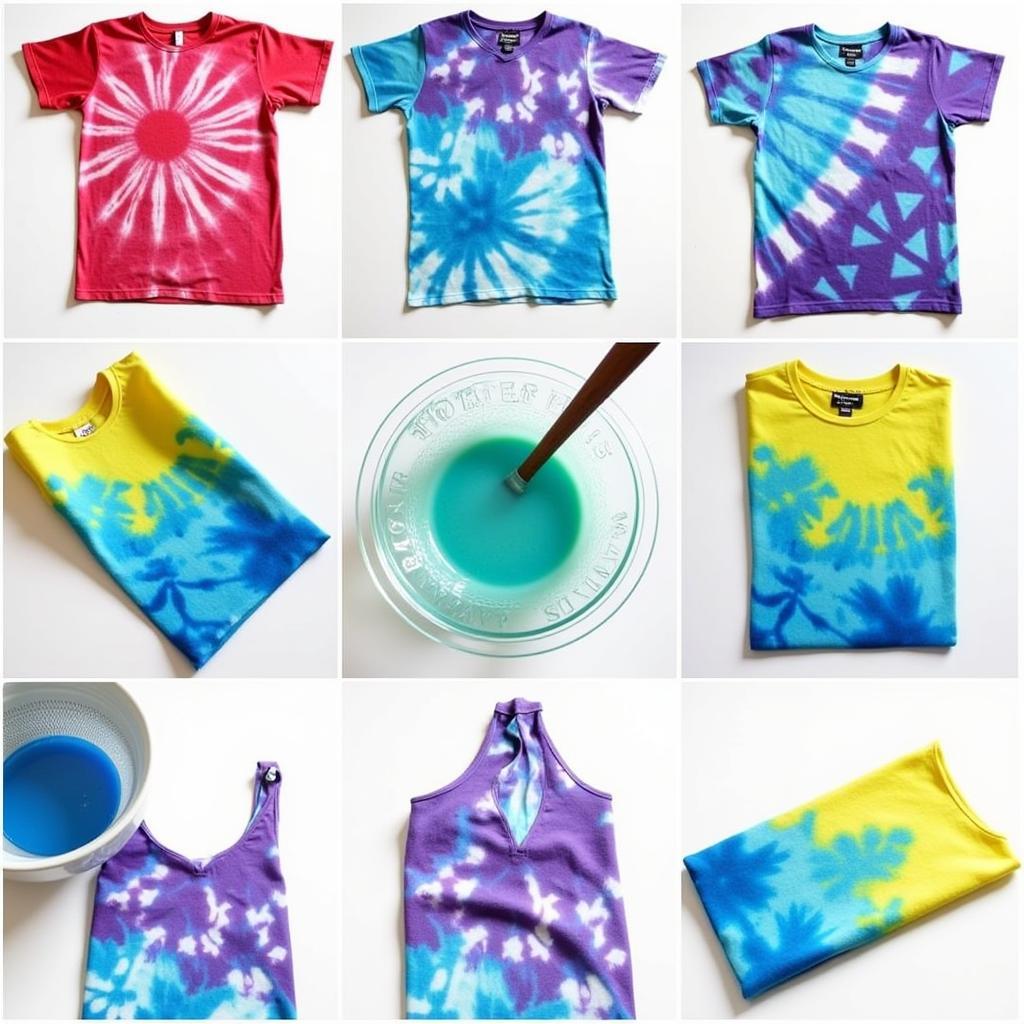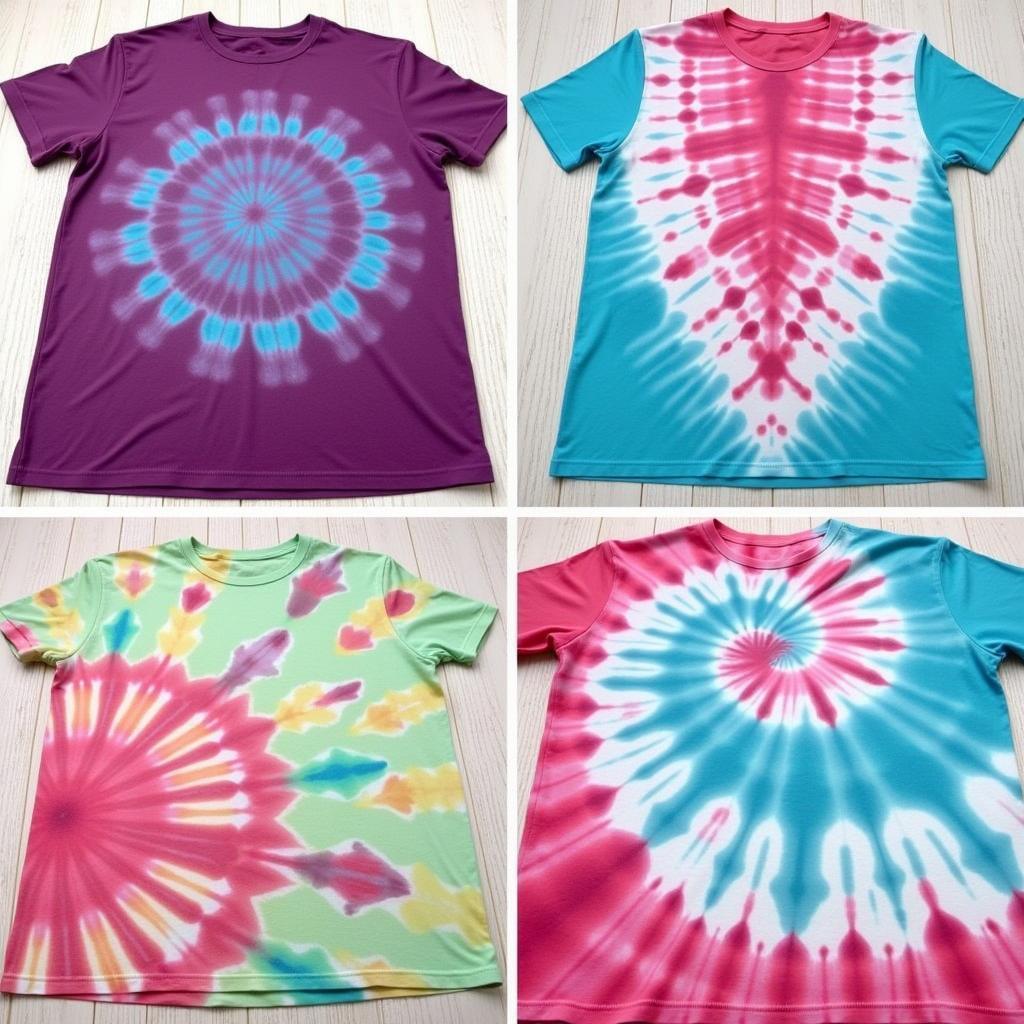Tie-dyeing is a vibrant and exciting way to transform plain colored shirts into wearable works of art. Whether you’re looking to refresh an old favorite or create something entirely new, tie-dye offers endless possibilities. But Can You Tie Dye Color Shirts? Absolutely! This article will guide you through the process of tie-dyeing colored shirts, offering tips and techniques to achieve stunning results.
Tie-Dyeing on Colored Shirts: A Colorful Adventure
Unlike dyeing white shirts, where the dye color appears as is, tie-dyeing on colored shirts involves a fascinating interplay of colors. The existing shirt color acts as a base, blending with the dye to create unique and often unexpected hues. This opens up a world of creative potential, allowing you to achieve effects you wouldn’t get on a white canvas. Imagine a deep purple shirt swirling with turquoise dye, or a bright yellow shirt infused with splashes of fuchsia. The possibilities are truly endless.
Choosing the Right Dye for Colored Shirts
When tie-dyeing colored shirts, the type of dye you choose is crucial. Fiber reactive dyes are the best option for natural fibers like cotton and rayon, as they bond permanently with the fabric, resulting in vibrant, long-lasting colors. For synthetic fabrics like polyester, you’ll need to use disperse dyes, which require a higher temperature to set. Using the correct dye ensures the color takes properly and doesn’t wash out. You might be wondering, can you use food color for tie dye? While food coloring can be a fun option for temporary projects, it’s not ideal for long-lasting tie-dye on clothing. For more information on using food coloring for tie-dye, check out can you use food color for tie dye.
Preparing Your Colored Shirt for Tie-Dye
Before you start tie-dyeing, it’s important to wash your shirt to remove any sizing or finishes that might interfere with the dye absorption. Don’t use fabric softener, as it can create a barrier that prevents the dye from penetrating the fibers. Soaking the shirt in a soda ash solution helps the dye bond better with the fabric, resulting in richer, more vibrant colors.
 Preparing Colored Shirts for Tie-Dyeing: Soaking and Folding Techniques
Preparing Colored Shirts for Tie-Dyeing: Soaking and Folding Techniques
Tie-Dye Techniques for Colored Shirts
A variety of tie-dye techniques can be used on colored shirts, each creating a unique pattern. The spiral, crumple, and bullseye techniques are popular choices, offering distinct visual effects. Experimenting with different folding and tying methods will allow you to discover your own signature style. You can achieve intricate designs or keep it simple with bold, sweeping patterns. If you’re interested in learning more about dyeing shirts with food coloring, you can find useful information on how to dye a shirt with food coloring.
Setting the Dye and Aftercare
After applying the dye, let the shirt sit for at least 24 hours to allow the colors to set. Then, rinse the shirt thoroughly in cold water until the water runs clear. Wash the shirt separately in cold water with a mild detergent for the first few washes to prevent any color bleeding. Knowing whether hydrogen peroxide will bleach colored clothes is also important. Find out more on will hydrogen peroxide bleach colored clothes.
Tips from a Color Expert
“When tie-dyeing colored shirts,” says renowned color specialist, Anya Sharma, “consider the color wheel. Complementary colors, those opposite each other on the wheel, can create striking contrasts. Analogous colors, those next to each other, produce a more harmonious effect.”
 Various Tie-Dye Techniques Applied to Colored Shirts: Spiral, Crumple, Bullseye
Various Tie-Dye Techniques Applied to Colored Shirts: Spiral, Crumple, Bullseye
Conclusion
Tie-dyeing colored shirts is a fun and creative way to personalize your wardrobe. By understanding the interplay of colors and choosing the right dyes and techniques, you can transform ordinary shirts into vibrant, one-of-a-kind pieces. Remember to experiment and have fun with the process! If you are curious about comfort color shirts, you might find our article on where to buy comfort color shirts helpful.
FAQ
- Can I tie-dye a 100% polyester shirt?
- What type of dye should I use for tie-dyeing a dark-colored shirt?
- How can I prevent the colors from bleeding after tie-dyeing?
- What are some easy tie-dye patterns for beginners?
- Can I tie-dye a shirt with multiple colors?
- How long should I let the dye sit on the shirt?
- Can I tie-dye a shirt that has already been dyed?
Scenarios
- Scenario 1: You want to tie-dye a light blue shirt with darker blue dye. The result will be a richer, deeper blue with interesting variations in shade.
- Scenario 2: You want to tie-dye a red shirt with yellow dye. The resulting color will be a warm orange or a reddish-orange depending on the intensity of the dyes.
- Scenario 3: You tie-dye a dark green shirt with a bright pink dye. You’ll likely achieve a muddy brown or a dark purplish hue.
Further Reading
Explore our other articles on color techniques: how do you make colored rice.
For any assistance, please contact us at Phone Number: 0373298888, Email: [email protected] or visit us at 86 Cau Giay, Hanoi. Our customer service team is available 24/7.

